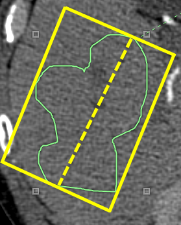Measuring an ROI
Introduction
Use the Region of Interest (ROI) options to calculate the average density and the standard deviation of that ROI. You can perform ROI measurements on an image with the following ROI types: rectangular, elliptical, polygonal, freehand, and auto detected (2pt).
ROI Measurement Considerations
When you create an ROI annotation, Synapse automatically calculates the average density of the ROI annotation. The resulting calculations use the pixel values of the displayed image. If the displayed image is Wavelet (lossy) compressed, the pixel values within a ROI might be different from the pixel values within the same ROI in the original version of that image.
Therefore, the mean and standard deviations of the ROI using the wavelet compressed image are likely to be different from the results calculated if the original image was used. Be aware of these ROI differences. The following indications display when viewing mean (M) and standard deviation (SD) values on a wavelet compressed image:
- SD: ~234 or M: ~456 - Indicates the value is approximate and different from the calculation of the original
Synapse hides the SD, M, Min, and Max values for any images that do not contain a modality transformation or if the image is not monochromatic. A tilde (~) displays before a value if the image quality is degraded. This includes the image pixel data and if the image's Lossy Image Compression tag (0028, 2110) has a value of 01.
|
Note: |
Synapse annotations do not use padded pixels for their results. Padded pixels will not be included for SD, Max, Min, and Mean calculations. |
Annotation Measurements
Each of these annotations includes the following measurements:
- Area - defined in square inches, square centimeters, or square millimeters
- Perimeter - defined in inches, centimeters, or millimeters
- Mean - calculated as average density (digital) value within the area of the annotation
- Standard Deviation - calculated from all density values within the ROI area to quantify the extent of the digital value variance
- Maximum Value - defined as the largest density value within the ROI
- Minimum Value - defined as the smallest density value within the ROI
- Length of Major Axis - defined as the longest line that connects the most distant points on the edge of the ROI
- Length of Minor Axis - calculated by drawing lines that are parallel and perpendicular to the major axis (shown as the dotted yellow line in the illustration) forming a rectangle (shown as solid yellow box) that contains the ROI. The minor axis is the length of the box that is perpendicular to the major axis

|
Note: |
The density units for mean, standard deviation, maximum value and minimum values vary depending on the modality. For example, CT uses Hounsfield Unit, and PT uses Standard Uptake Values (SUV). To change the SUV correction method, see Change the SUV Correction Method. |
Freehand ROI
A Freehand ROI can be drawn to measure arbitrary points on the image. If you use the freehand ROI to draw an open freehand curve, Synapse measures the length of the freehand annotation.
Standardized Uptake Value
A Standardized Uptake Value (SUV) represents a quantitative measurement for relative tissue uptake of a radio tracer in Positron Emission Tomography (PET) images. SUVs are calculated based on the data contained in the image's DICOM tags and are calculated for most PET images.
Synapse correlates the SUV for a patient according to the specified SUV correction method (see Configuring Annotations Settings).